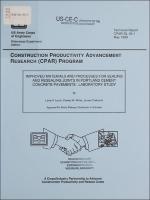Please use this identifier to cite or link to this item:
https://hdl.handle.net/11681/4695| Title: | Improved materials and processes for sealing and resealing joints in Portland cement concrete pavements : laboratory study |
| Authors: | Lynch, Larry N. White, D. W. (Dewey W.) Chehovits, J. G. (James G.) |
| Keywords: | Federal Specification SS-S-1401 Federal Specification SS-S-1614 Hot-applied joint sealants Jet-fuel-resistant sealants Non-jet-fuel-resistant sealants Portland cement concrete Concrete pavements Sealing compounds Sealants Design Construction Productivity Advancement Research Program (U.S.) |
| Publisher: | U.S. Army Engineer Waterways Experiment Station |
| Series/Report no.: | Technical Report (Construction Productivity Advancement Research Program (U.S.)) ; no.Technical Report CPAR-GL-93-1 |
| Abstract: | A joint effort research program between Crafco Incorporated and the US Army Engineer Waterways Experiment Station was conducted under the auspices of the FY 89 Construction Productivity Advancement Research Program. The purpose was to develop improved materials and processes for sealing and resealing joints in portland cement concrete pavements. The program's objectives were to (A.) develop specification limits for a hot-applied, jet-fuel-resistant (JFR) sealant with improved characteristics as compared to current Federal Specification (FS) SS-S-1614A requirements, (B.) develop specification limits for a hot-applied, non-jet-fuel-resistant (non-JFR) sealant with improved low temperature performance characteristics as compared to current FS SS-S-1401C requirements, (C.) develop specification limits for a primer system that will minimize bubbling tendencies associated with hot-applied sealants and improve adhesion to portland cement concrete, and (D.) develop field data to determine performance characteristics of flush fill sealant application geometry versus 1/8 to 1/4 in. recess application techniques. This report summarizes the laboratory investigation phases of the research program. Field evaluations of the materials developed to meet these specifications are being conducted to determine actual maintenance cost reductions and improved construction quality. Prior to initiating sealant development activities, testing of available sealant materials was performed to identify the level of laboratory performance of currently available hot-applied, JFR and non-JFR sealants. Thirteen different sealants from four manufacturers were tested for specification conformance to FS SS-S-1614A and FS SS-S-1401C. Additional testing procedures were also used to aid in determining performance limits. Testing verified that the JFR sealants tested were not capable of passing bond tests at -20°F, and that they experience significant amounts of surface hardening when subjected to 158°F oven-aging. Non-JFR sealants tested varied in low temperature extension capabilities. Products which met low-modulus ASTM D 3405 specifications were capable of passing bond testing at -20°F using 200 percent extension, while the FS SS-S-1401C materials could not. Laboratory development work determined that it was possible to produce hot-applied, JFR sealant materials which could pass bond testing at -20°F, and with less surface hardening after aging. A suggested specification was developed for this improved material, and a pilot production batch of sealant meeting this specification was made. Additionally, a suggested specification for a low-modulus non-JFR sealant with improved low temperature properties was developed, and a pilot production batch of sealant meeting this specification was made. Both sealants were installed at Fairchild AFB, WA, for field evaluation. The results of the field evaluation of the improved sealants versus commercially available sealants are presented in a separate report. Bubbling characteristics of sealants were studied using the US Army Corps of Engineers' Handbook for Concrete and Cement CRD-C 525-89 procedure along with several modifications to better understand the bubbling problem. Data indicate that as little as 0.5 percent moisture in portland cement concrete (PCC) can cause sealant bubbling. A quantitative method to monitor bubbling rate was developed. A variety of potential encapsulating primer formulations were studied. Results indicated that when the appropriate primer system is used on PCC, swelling and bubbling of sealants can be reduced. Appropriate adhesion could not be obtained between the sealant and PCC pavement when the developmental JFR primers were used. The developmental non-JFR primers increased sealant adhesion and reduced sealant bubbling in the laboratory. A suggested specification for primer for use with non-JFR sealant for PCC pavements was developed, and a pilot production batch of primer to meet this specification was made for field evaluation at Fairchild AFB, WA. |
| Description: | Technical Report |
| Gov't Doc #: | Technical Report CPAR-GL-93-1 |
| Rights: | Approved for public release; distribution is unlimited |
| URI: | http://hdl.handle.net/11681/4695 |
| Appears in Collections: | Technical Report |
Files in This Item:
| File | Description | Size | Format | |
|---|---|---|---|---|
| TR-CPAR-GL-93-1.pdf | Technical Report CPAR-GL-93-1 | 29.2 MB | Adobe PDF |  View/Open |